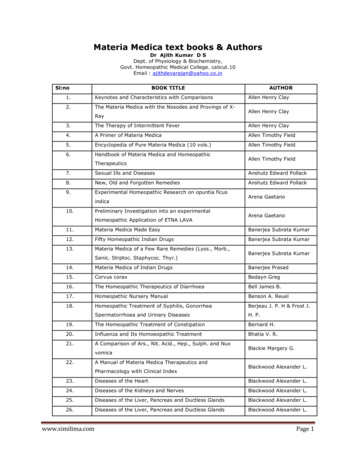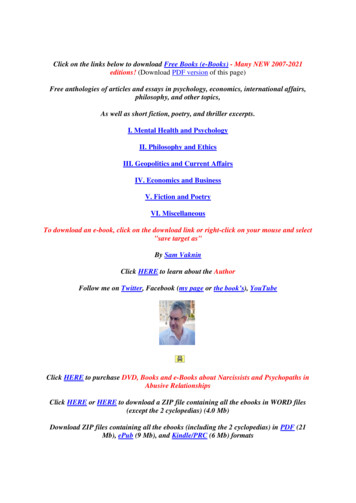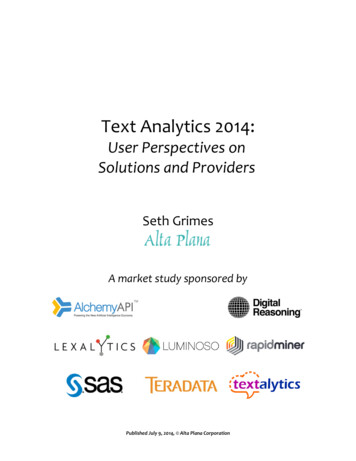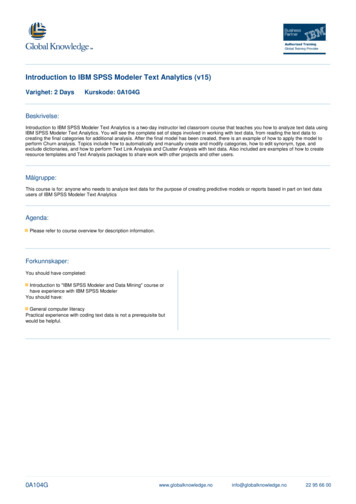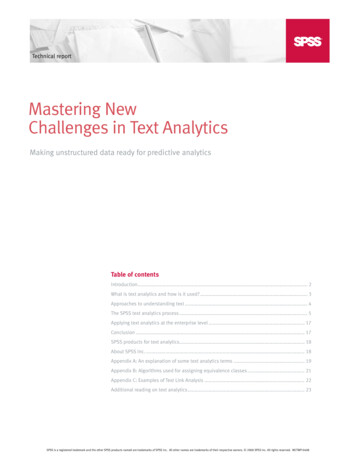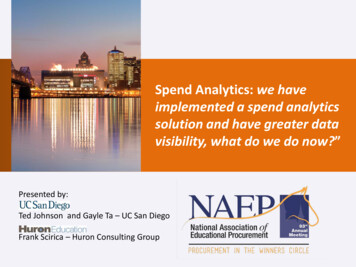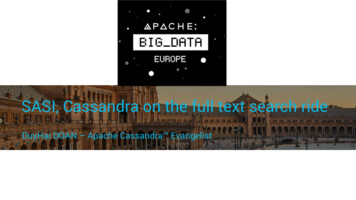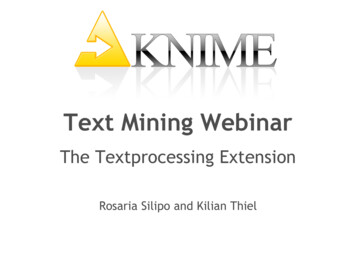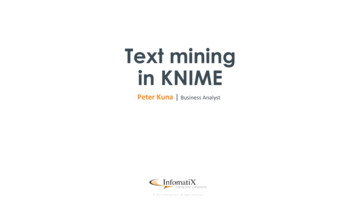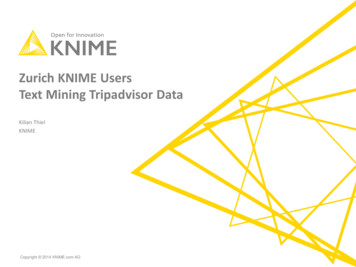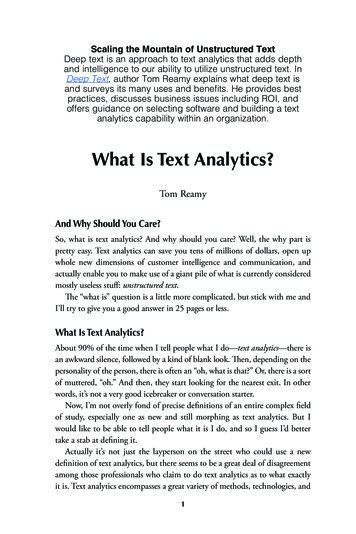
Transcription
Scaling the Mountain of Unstructured TextDeep text is an approach to text analytics that adds depthand intelligence to our ability to utilize unstructured text. InDeep Text, author Tom Reamy explains what deep text isand surveys its many uses and benefits. He provides bestpractices, discusses business issues including ROI, andoffers guidance on selecting software and building a textanalytics capability within an organization.What Is Text Analytics?Tom ReamyAnd Why Should You Care?So, what is text analytics? And why should you care? Well, the why part ispretty easy. Text analytics can save you tens of millions of dollars, open upwhole new dimensions of customer intelligence and communication, andactually enable you to make use of a giant pile of what is currently consideredmostly useless stuff: unstructured text.The “what is” question is a little more complicated, but stick with me andI’ll try to give you a good answer in 25 pages or less.What Is Text Analytics?About 90% of the time when I tell people what I do—text analytics—there isan awkward silence, followed by a kind of blank look. Then, depending on thepersonality of the person, there is often an “oh, what is that?” Or, there is a sortof muttered, “oh.” And then, they start looking for the nearest exit. In otherwords, it’s not a very good icebreaker or conversation starter.Now, I’m not overly fond of precise definitions of an entire complex fieldof study, especially one as new and still morphing as text analytics. But Iwould like to be able to tell people what it is I do, and so I guess I’d bettertake a stab at defining it.Actually it’s not just the layperson on the street who could use a newdefinition of text analytics, but there seems to be a great deal of disagreementamong those professionals who claim to do text analytics as to what exactlyit is. Text analytics encompasses a great variety of methods, technologies, and1
2 Deep Textapplications, so it shouldn’t be too much of a surprise that we haven’t quitenailed it down yet.To make matters worse, there are all sorts of claimants for the title of“what I do is the REAL text analytics.” For one, “text mining” often claimsto deal with all things text. Then, the so-called “automatic categorization”companies will tell you that they do all you need to do with text. And finally,the “semantic technology” or the “semantic web” people not only claim theword semantic as their own but also that what they do is the essential way ofutilizing unstructured text.I’m also a firm believer in Wittgenstein’s notion of family resemblances,that is, for any complex field, there is no one or two essential characteristics,but rather a family of overlapping characteristics that define what it is—yet another reason why I’m suspicious of attempts to define something ascomplex as text analytics in a one-sentence definition.But, we still have to try.Text Analytics Is In my view, the term text analytics should be defined in the broadest possibleway. Almost anything that someone has described as text analytics belongswithin the definition.In essence, what we’re trying to do is add structure to unstructured/semistructured text—which includes everything from turning text into data, todiving down into the heart of meaning and cognition, through to makingthat text more understandable and usable.My “big tent” definition of text analytics includes, for example: Text mining The latest mathematical, vector space, or neural network model The grunt work of putting together vocabularies and taxonomies The development of categorization rules, the application of thoserules, advanced automated processing techniques—everything fromyour company’s official anti-discrimination policy to the chaos ofTwitter feeds The development and use of sophisticated analytical and visualfront ends to support analysts trying to make sense of the trendsin 20 million email threads, or the political and social rantings ofmillions of passionate posters, both evil and heroic (depending onyour point of view)
Deep Text 3So, with all those caveats (or quibbles) in mind, the essential componentsof “big tent” text analytics are: Techniques – linguistic (both computational and natural language),categorization, statistical, and machine learning Semantic structure resources – dictionaries, taxonomies, thesauri,ontologies Software – development environment, analytical programs,visualizations Applications – business intelligence, search, social media and awhole lot moreWe will go into each of these components in more detail, but one thingthey all have in common: They are all used to process unstructured or semistructured text. And so, the fifth essential component of text analytics is: Content – unstructured or semi-structured text, including voicespeech-to-textThe output of all this text processing varies considerably. A short listincludes: Counting and clustering words in sets of documents as a way ofcharacterizing those sets Analyzing trends in word usage in sets of documents as part ofbroader analyses of political, social and economic trends Developing advanced statistical patterns of words and clusteringof frequently co-occurring words, which can be used in advancedanalytical applications—and as a way to explore document orresults sets Extracting entities (people, organizations, etc.), events, activities,etc., to make them available for use as data or metadata,specifically:¡ Metadata to improve search results¡ Turning text into data, such that all our advanced data analyticaltechniques can be applied Identifying and collecting user and customer sentiment, opinions,and technical complaints to feed programs that support everythingcustomer—customer relations, early identification of productissues, brand management and even technical support
4 Deep Text Analyzing the deeper meaning and context around words to moredeeply understand what the word, phrase, sentence, paragraph,section, document, and/or corpus is about—this is perhaps themost fundamental and the most advanced technique that is usedfor everything from search (“aboutness”) to adding intelligence orcontext to every other component and application of text analyticsContent and Content ModelsWith a name like text analytics, it should come as no surprise that the primarycontent of text analytics is text! But having said that, we haven’t said much,so let’s look a little more deeply. The stuff that text analytics operates on isall kinds of text from simple notepad text to Word documents and websites,blogger forum posts, Twitter posts, and so on. In other words, anything thatcan be expressed in words (and can be input into a computer one way oranother) is fair game for text analytics.What we don’t deal with are things like video, although there are a numberof applications that incorporate video into a text analytics application, eitherby generating a transcript of all the spoken words in a video and/or operatingon any text metadata descriptions of the video.Text analytics also does not deal directly with data, although again, thereis an enormous amount of data incorporated into text analytics applicationsat a variety of levels.This type of text is often referred to as unstructured text, but that is notreally accurate. If it were really unstructured text, we wouldn’t be able tomake any sense out of it. A slightly more accurate description would be semistructured text, which is what a lot of people call it.However, this does not really capture the essence of the kinds of text thattext analytics is applied to. Only someone raised in a world in which databasesrule would come up with the term semi-structured. More accurate termswould be multi-structured, or even advanced-structured (OK, that’s probablya bit much).The reality is, this type of text is structured in a wide variety of ways, somefairly primitive and simple, and still others exemplifying the height of humanintelligence.Let’s start with the primitive and simple structure of the text itself. Inmost languages, ranging from English to Russian to Icelandic, the first levelof structure consists of letters, spaces and punctuation marks. We won’t bedealing much at the level of letters, although in English and other similar
Deep Text 5languages, spaces are how we define the second level of structure—words.Also, punctuation marks are important—particularly for the third level ofstructure, namely phrases, clauses, sentences and paragraphs—and this is wherethe concept of meaning structures comes into play.For obvious reasons, words—the second level of meaning structure—arethe basic unit that we deal with in text analytics, normally in conjunctionwith the third-level meaning structure of phrases, clauses, sentences, andparagraphs. We don’t want to get too bogged down in linguistic theory, butwe do use words, phrases, clauses, sentences, and paragraphs in text analyticsrules.For example, a standard rule would be to look for two words within thesame sentence, and count them differently than finding those two wordsseparated by an indeterminate amount of text. In other words, it is usuallymore important to find two words in the same sentence than two words indifferent sentences that happen to be within five words of each other.The next level of meaning structure is that of sections within documents,which can be defined in a wide variety of ways and sizes, but this is where itgets really interesting in terms of text analytics rules. Structuring a documentin terms of sections typically improves readability, but it can also lead to verypowerful text analytics rules.For example, in one application we developed rules that dynamicallydefined a number of sections, which included things like abstracts,summaries, conclusions, and others. The words that define these sectionswere varied and so had to be captured in a rule, but then that gave usthe ability to count the words, phrases and sentences that appearedin those sections as more important than those in the simple body ofthe document.Metadata—Capturing and Adding StructureThe last type of structure is metadata—data or structure that is added to thedocument, either by authors, librarians, or software. This includes things suchas title, author, date, all the rest of the Dublin Core,1 and more. Currently,the most popular and successful approach to metadata is done with what arecalled facets—or faceted metadata.Metadata may not have the exalted meaning of metaphysics and the like,but nevertheless, it is a fundamental and powerful tool for a whole varietyof applications dealing with the semantic structure of so-called unstructuredtext.
6 Deep TextThe Meaning of “Meta”Whenever I write about metadata, I’m always struck by the varietyof meanings that the word “meta” has accumulated over the centuries. These meanings range from the mundane—metadata is dataabout data—to the sublime of metaphysics and all the associateduses based on the fundamental meaning of something higher thannormal reality.On a more personal note, it always reminds me of weird littlefacts that we pick up. As an undergraduate student, I decided thatrather than take the standard French or Spanish as my foreign language, I would study ancient Greek. I’m still not sure why I did,but my guess is it had something to do with the fact that I was alsoreading James Joyce’s Ulysses at the time. Whatever the reason, I tooktwo-and-a-half years of it!And that is where I came across this weird little fact about theword “meta:” In Greek, “meta” has a few basic meanings, but thesemeanings really took off after a librarian in Alexandria attemptedto categorize all of Aristotle’s works. He had just finished the volume/scroll on physics, and the next work he picked up was thisstrange work on the nature of reality. And so the story goes: Hedidn’t know what to call it, so he called it metaphysics, which inGreek simply meant “the volume that came after the volume onphysics.” A humble beginning for a word that has come to meanso much.What text analytics does in the area of metadata is twofold. First, itincorporates whatever existing metadata there is for a document into itsown rules. For example, if there is an existing title for a document, then atext analytics rule can count the words that appear in the title as particularlysignificant for determining what the document is all about.The second role for text analytics is to overcome the primary obstacleto the effective use of metadata—actually tagging documents with
Deep Text 7good metadata values. In particular, this is an issue for faceted metadataapplications, which require massive amounts of metadata to be addedto documents.We will explore this topic in more detail in Chapter 10, Text AnalyticsApplications, but the basic process that has had the most success is to combinehuman tagging with automatic text analytics-driven tagging. This hybridapproach combines the intelligence of the human mind with the consistencyof automatic tagging—the best of both worlds.Text analytics is also ideally suited to pulling out values for facets, suchas “people” and “organizations,” that enable users to filter search resultsmore effectively (see Chapter 10 for more on facets and text analytics). Textanalytics can also pull out more esoteric facets, such as for one project wherewe developed rules to pull out all the mentions of “methods”—everythingfrom analytical chemical methods to statistical survey methods.However, the most difficult (but also the most useful) metadata arekeywords and/or subject—in other words, what the document’s key conceptsare and what the document is about. This is where text analytics adds themost value.Subject and keywords metadata are typically generated by the text analyticscapability of auto-categorization, which we will more fully discuss later in thechapter.Text analytics uses a variety of meaning-based resources to implementauto-tagging and other metadata assignments. The basic resource is sometype of controlled
it is. Text analytics encompasses a great variety of methods, technologies, and Scaling the Mountain of Unstructured Text Deep text is an approach to text analytics that adds depth and intelligence to our ability to utilize unstructured text. In Deep Text, author Tom Reamy explains what deep text is and surveys its many uses and benefits. He provides best
